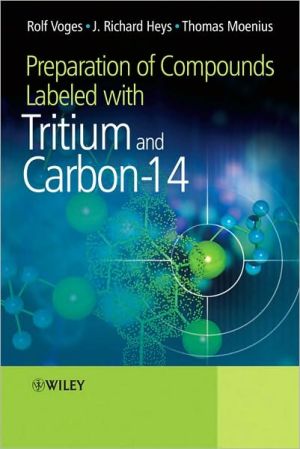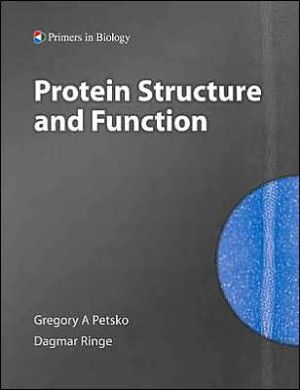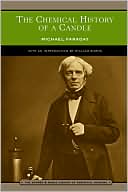Preparation of Compounds Labeled with Tritium and Carbon-14
Compounds labeled with carbon-14 and tritium are indispensable tools for research in biomedical sciences, discovery and development of pharmaceuticals and agrochemicals.\ Preparation of Compounds Labeled with Tritium and Carbon-14 is a comprehensive, authoritative and up-to-date discussion of the strategies, synthetic approaches, reactions techniques, and resources for the preparation of compounds labeled with either of these isotopes. A large number of examples are presented for the use of...
Search in google:
Compounds labeled with carbon-14 and tritium are indispensable tools for research in biomedical sciences, discovery and development of pharmaceuticals and agrochemicals. Preparation of Compounds Labeled with Tritium and Carbon-14 is a comprehensive, authoritative and up-to-date discussion of the strategies, synthetic approaches, reactions techniques, and resources for the preparation of compounds labeled with either of these isotopes. A large number of examples are presented for the use of isotopic sources and building blocks in the preparation of labeled target compounds, illustrating the range of possibilities for embedding isotopic labels in selected moieties of complex structures. Topics include: Formulation of synthetic strategies for preparing labeled compounds Isotope exchange methods and synthetic alternatives for preparing tritiated compounds In-depth discussion of carbon-14 building blocks and their utility in synthesis Preparation of enantiomerically pure isotopically labeled compounds Applications of biotransformations Preparation of Compounds Labeled with Tritium and Carbon-14 is an essential guide to the specialist strategies and tactics used by chemists to prepare compounds tagged with theradioactive atoms carbon-14 and tritium.
Preface xiGlossary xiiiAuthor Biographies xvii1 Introduction 11.1 Physical Properties of Tritium and Carbon-14 31.2 Purification 51.3 Analysis 61.3.1 Chemical Identity 61.3.2 Chemical (and Enantiomeric) Purity 71.3.3 Radiochemical (and Radionuclidic) Purity 81.3.4 Specific Activity 91.3.5 Position of Label 101.4 Stability and Storage of Compounds Labeled with Tritium or Carbon-14 111.5 Specialist Techniques and Equipment 15References 212 Strategies for Target Preparation 252.1 Formulating Target Specifications 262.2 Planning Radiotracer Preparations 312.2.1 The Construction Strategy 312.2.2 Reconstitution Strategies 322.2.3 The Derivatization Strategy 342.2.4 Selection of an Appropriate Strategy 342.2.5 Case Studies of Strategy Development 36References 443 Preparation of Tritium-Labeled Compounds by Isotope Exchange Reactions 473.1 Homogeneous Acid-or Base-Catalyzed Exchange 493.1.1 Exchange without Added Acid or Base 493.1.2 Exchange under Acidic Conditions 513.1.3 Exchange under Basic Conditions 563.2 Heterogeneous Catalysis with Tritium in Solvent 603.2.1 Metals 613.2.2 Other Catalysts 653.3 Heterogeneous Catalysis in Solution with Tritium Gas 663.3.1 Metal Catalysts with Nonreducible Substrates in Aqueous Solution 673.3.2 Metal Catalysts with Nonreducible Substrates in Organic Solvents 683.3.3 Other Catalysts 693.3.4 Metal Catalysts with Reducible Substrates 703.4 Homogeneous Catalysis in Solution with Tritiated Water 713.4.1 Exchange Catalyzed by Metal Salts 713.4.2 Exchange Catalyzed by Organoruthenium Complexes 733.4.3 Exchange Catalyzed by Iridium Dionates743.4.4 Exchange Catalyzed by Iridium Cyclopentadienides 763.5 Homogeneous Catalysis with Tritium Gas 773.5.1 Iridium Phosphines 773.5.2 Iridium Dionate Complexes 903.5.3 Iridium Cyclopentadienide Complexes 913.6 Solvent-Free Catalytic Exchange 933.6.1 High-Temperature Solid-State Catalytic Isotope Exchange 933.6.2 Thermal Tritium Atom Bombardment 963.6.3 Other Radiation-Induced Labeling Methods 97References 984 Preparation of Tritium-Labeled Compounds by Chemical Synthesis 1094.1 Catalytic Tritiations 1104.1.1 Tritiation of Carbon-Carbon Multiple Bonds 1114.1.2 Tritiation of Carbon-Heteroatom Multiple Bonds 1254.1.3 Homogeneously Catalyzed Reactions 1264.2 Catalytic Tritiolyses 1324.2.1 Tritiodehalogenations 1334.2.2 Tritiolyses of Benzylic N- and O-Functions 1444.2.3 Tritiodesulfurizations 1454.3 Tritide Reductions 1464.3.1 Sodium Borotritide (NaB3H4) 1484.3.2 Sodium Cyanoborotritide (NaB3H3CN) 1574.3.3 Sodium/Tetramethylammonium Triacetoxyborotritide [Na/NMe4B3H(OAc)3] 1594.3.4 Lithium Tritide (Li3H) 1604.3.5 Lithium Borotritide (LiB3H4) 1614.3.6 Lithium Triethylborotritide (LiEt3B3H, Li-Super-Tritide) 1634.3.7 Lithium Tri-sec-Butylborotritide [Li(sec-Bu3)B3H, Li T-Selectride] 1654.3.8 Lithium [3H2]Boratabicyclo[3.3.1]nonane 1664.3.9 Tritiated Borane (THF-Complex) (B23H6; B3H3.THF) 1674.3.10 Tritiated Alkylboranes 1694.3.11 Lithium Aluminum Tritide (LiAl3H4) 1704.3.12 Tri-n-Butyltin Tritide (n-Bu3Sn3H) 1724.3.13 Tritiated Schwartz's Reagent (ZrCp2Cl3H) 1764.3.14 Tritiated Triethylsilane and Trihexylsilane 1774.4 Small Tritiated Building Blocks 1784.4.1 Tritiated Water (3H2O; 3HHO) 1794.4.2 Tritiated Diimide (3HN = N3H) 1824.4.3 Tritiated Methyl Iodide (C3H3l; C3HH2I) 1834.4.4 Tritiated Diiodomethane (C3HHI2) 1904.4.5 Tritiated Formaldehyde (3HCHO, 3HC3HO) 1914.4.6 Dimethyl [3H]formamide (3HCONMe2), Acetic [3H]Formic Anhydride (3HCOOCOMe) 1924.4.7 Tritiated Diazomethane (C3HHN2) 1934.4.8 N-Tritioacetoxyphthalimide 1944.4.9 N-Succinimidyl [2,3-3H]Propionate ([3H]NSP) 195References 1955 Barium [14C]Carbonate and the Preparation of Carbon-14-Labeled Compounds via One-Carbon Building Blocks of the [14C]Carbon Dioxide Tree 2115.1 [14C]Carbon Dioxide (14CO2) 2125.1.1 [14C]Carboxylations of Organometallic Compounds 2125.1.2 Manipulations of [14C]Carboxylation Products 2185.1.3 N-[14C]Acyl Building Blocks 2195.1.4 Preparation of Other Building Blocks from [14C]Carbon Dioxide 2215.2 [14C]Carbon Monoxide (14CO) 2225.2.1 [14C]Phosgene 2295.3 [14C]Formic Acid (H14COOH) 2335.4 [14C]Formaldehyde (H14CHO) 2405.4.1 Carbanion-Mediated Hydroxy[14C]methylation and [14C]Methylenenation 2425.4.2 Acid-Catalyzed Hydroxy[14C]methylations 2465.4.3 Amino[14C]methylation 2485.4.4 Reductive Methylations 2545.4.5 Polycondensations 2555.4.6 Thio[14C]methylations 2565.5 [14C]Methyl Iodide (14CH3I) 2565.5.1 [14C]Methyl Iodide as an Electrophilic One-[14C]Carbon Building Block 2575.5.2 [14C]Methyl Iodide as a Source of Nucleophilic [14C]Methyl and [14C]Methylene Building Blocks 2625.5.3 Further Building Blocks Derived from [14C]Methyl Iodide 2685.6 [14C]Nitromethane (14CH3NO2) 270References 2776 Preparation of Carbon-14-Labeled Compounds via Multi-Carbon Building Blocks of the [14C]Carbon Dioxide Tree 2876.1 [14C]Acetic Acid and Its Derivatives 2876.1.1 [14C]Acetic Acid 2876.1.2 [14C]Acetyl Chloride 2896.1.3 [14C]Acetic Anhydride 2986.1.4 [14C]Acetic Acid Alkyl/Aryl Esters 3016.2 Halo[14C]acetates 3076.2.1 Reaction at the Carboxyl Group 3096.2.2 Reactions at the Methylene Group 3126.2.3 Reactions at the Halogen Atom 3146.3 [14C]Acetone 3376.3.1 Reaction at the Carbonyl Group 3386.3.2 Reaction at the Methyl Group 3436.4 Alkyl [14C]Acetoacetate 3466.4.1 Alkylation Reactions 3486.4.2 Acylation Reactions 3516.4.3 Aldol Reactions 3526.4.4 Knoevenagel-Michael Reactions 3536.4.5 Reactions at the Functional Groups 3566.5 [14C]Malonates 3576.5.1 Reactions at the Methylene Group 3596.5.2 Reactions at the Carboxyl Functions 374References 3817 Preparation of Carbon-14-Labeled Compounds via the [14C]Cyanide Tree 3937.1 Metal [14C] Cyanides 3937.1.1 Preparation 3937.1.2 Introduction of [14C]Cyanide into Organic Substrates 3947.1.3 Synthetic Transformations of Organic [14C]Nitriles 3997.2 Preparation of Other Building Blocks from [14C]Cyanide 4117.2.1 Trimethylsilyl[14C]Cyanide (TMS14CN) 4127.2.2 [14C]Cyanogen Bromide (Br14CN) 4137.2.3 Alkali Metal [14C]Cyanates (M14CNO; M = Na, K) 4157.2.4 Alkali Metal Thio[14C]cyanate (M14CNS; M = Na, K) 4177.2.5 Triethy [14C]Orthoformate [H14C(OEt)3] 4197.2.6 [14C]Cyanoacetic Acid [14CNCH2COOH] 4207.2.7 [14C]Diazomethane (14CH2N2) 431References 4338 Preparation of Carbon-14-Labeled Compounds via the [14C2]Acetylene Tree 4418.1 [14C2]Acetylene (H14C = 14CH) 4418.2 [14C2]Acetaldehyde (14CH314CHO) 4458.3 [1,2-14C2]Acetic Acid (14CH314COOH) 4468.4 2-[2,3-14C2]Propyne-1-ol ([2,3-14C2]Propargyl Alcohol) and 2-[2,3-14C2]Butyne-1,4-diol 4478.5 Methyl [2,3-14C2]Propiolate (H14C$$14CCOOMe) and Dimethyl [2,3-14C2]Acetylenedicarboxylate (HOOC14C$$14CCOOH) 4478.6 1,2-[14C2]Dibromoethane (Br14CH214CH2Br) 4488.7 [14C2]Ethylene Oxide 4488.8 [14Cn]Benzene and the Synthesis of Ring-Labeled Aromatic Compounds 4488.8.1 Nitrobenzene Branch 4518.8.2 Phenol Branch 4548.8.3 Bromobenzene Branch 4568.8.4 Iodobenzene Branch 4578.8.5 Benzoic Acid Branch 4588.8.6 Alkyl Phenyl Ketone Branch 4598.8.7 Sulfonylbenzene Branch 459References 4609 Preparation of Carbon-14-Labeled Compounds via the [14C]Cyanamide Tree 4659.1 [14C]Cyanamide (H2N14C$$N) 4659.2 [14C]Guanidine (H2N14C(=NH)NH2) 4679.3 [14C]Urea, H2N14CONH2 4689.4 [14C]Thiourea, H2N14CSNH2 472References 47710 Reconstitution Strategies 47910.1 Replacement Strategies 47910.1.1 1H/3H Replacement Strategies 47910.1.2 12C/14C Replacement Strategies 48510.2 Disconnection-Reconnection Strategies 48810.2.1 Dealkylation-Re[3H/14C]alkylation Procedures 48810.2.2 CO2/14CO2 Replacement Strategies 49210.2.3 CO/14CO Replacement Strategy 50110.2.4 Oxidative Cleavage of C=C Bonds in the Reconstitution Approach 502References 51711 Preparation of Enantiomerically Pure Compounds Labeled with Isotopes of Hydrogen and Carbon 52311.1 Resolution of Racemates 52411.2 Enantioselective Synthetic Methods 52911.2.1 Hydrogenation/Tritiation of Labeled/Unlabeled Δ2,3-Amino Acid Derivatives 53011.2.2 Reduction of Labeled Prochiral Carbonyl Compounds and Oximes 53511.2.3 Enantioselective Oxidation of Olefins and Allylic Alcohols 54111.3 Diastereoselective Synthetic Procedures 54611.3.1 α-Alkylation of Chiral Imide Enolates 55111.3.2 Aldol Reactions of Chiral Imides and Ester Enolates 55811.3.3 1,4-Additions of Chiral Imide Enolates to Michael Acceptors 56411.3.4 α-Amination of Chiral Imide Enolates 56611.3.5 α-Hydroxylation of Chiral Imide Enolates 57111.3.6 α-Alkylation of Chiral Glycinates 57111.3.7 Aldol Reactions of Chiral Glycinates 58311.3.8 Aldol Reactions of Chiral Glycolates 58611.3.9 Aldol Reactions of Chiral Haloacetates 58611.3.10 Reactions on Chiral α,β-Unsaturated Imides and Esters 591References 59612 Biotransformations in the Preparation of Compounds Labeled with Carbon and Hydrogen Isotopes 60712.1 Applications of Isolated Enzymes 60812.1.1 Optical Resoultions via Derivatives 60812.1.2 Synthesis of Isotropically Labeled, Enantiomerically Pure Compounds 61212.1.3 Conjugation Reactions 61812.2 Application of Cell-Containing Systems 61812.2.1 Transformations of Functional Groups 61912.2.2 Fermentative Synthesis of Structurally Complex Molecules by Incorporation of Labeled Precursors 62112.2.3 Specific Requirements for Fermentations Using Isotopically Labeled Compounds 62312.3 Biocatalyzed Synthesis of Key Intermediates for Reconstitution Approaches 63012.3.1 Oxidation-Reduction Approach 63112.3.2 Dealkylation-Realkylation Approach 632References 634Index 639








